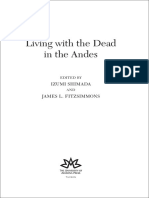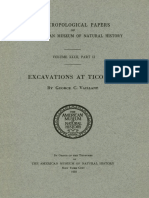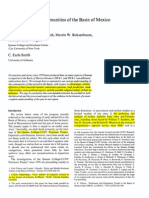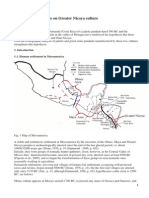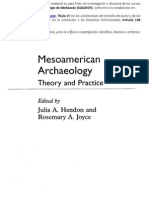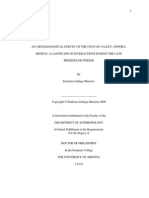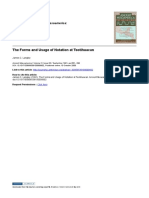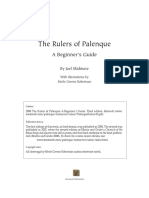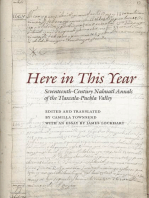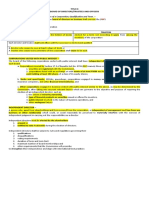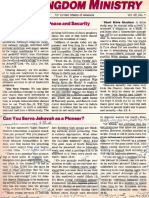Secrets Casas Grandes
Secrets Casas Grandes
Uploaded by
Voicu DragomirCopyright:
Available Formats
Secrets Casas Grandes
Secrets Casas Grandes
Uploaded by
Voicu DragomirOriginal Description:
Copyright
Available Formats
Share this document
Did you find this document useful?
Is this content inappropriate?
Copyright:
Available Formats
Secrets Casas Grandes
Secrets Casas Grandes
Uploaded by
Voicu DragomirCopyright:
Available Formats
Secrets of
Melissa S. Powell, Ph.D.
Curator of Archaeology Museum of Indian Arts and Culture/ Laboratory of Anthropology
asas Grandes holds many secrets, some of which have been revealed through archaeology, and others we have yet to unlock. It is a story of remote ruins, precious artifacts, and scientific discoveries but more importantly, it is the record of the lives of the people of Casas Grandes. The prehispanic culture is primarily known for its beautiful ceramic tradition, although the real story is about the people who made and used the pottery and about a past culture of the Southwest that emerged in a desert valley of northern Chihuahua over eight hundred years ago. In a time before there was an international border between Mexico and the United States, in the thirteenth century, the people of Casas Grandes built a city like no other. We dont know what they called their home, but today it is known as Paquim. During the Medio period of a.d. 12001450, the prehistoric city was the center of the Casas Grandes world. Exotic goods
32 E l P a l a c i o
Casas Grandes
ABOVE: Several hundred T-shaped doorways were found at Paquim. Photograph by Leif Percifield. LEFT: Casas Grandes plain ware effigy jar with closed eyes, Casas Grandes, a.d. 12001450. Museum of Indian Arts and Culture/ Laboratory of Anthropology, 8335/11.
El Palacio
33
secrets of casas grandes
ABOVE: Adobe architecture at Paquim, the largest Casas Grandes site.
RIGHT: Charles Di Peso examining a macaw pen at Paquim. Macaws were symbolically important and prized for their feathers, which were traded to other areas of the Southwest. Courtesy of the Amerind Foundation, Inc., Dragoon, Arizona.
at the sitecopper, shell, turquoise, and macawstell us that Casas Grandes participated in a widespread trade and interaction network that extended from northern Chihuahua into what is today the US Southwest. In many aspects Paquim looks like a Southwestern pueblo, with multistory adobe roomblocks bordering plazas and pottery that is clearly part of the Southwestern polychrome tradition. In other ways, Casas Grandes is an enigma. Ballcourts, monumental architecture, a stratified social hierarchy, macaw breeding, and ceramic effigies all suggest Mesoamerican influences. Casas Grandes is not uniquely Puebloan or Mesoamerican; it blends elements of both cultures. Located far north of classic Mesoamerica and south of the US Southwest, Casas Grandes has often been overlooked from both sides of the border, despite being one of the largest and most significant cultures of its time. Explorers and travelers to the Chihuahuan desert encountered arid basins separated by the Sierra Madre Occidental Mountains and by three river valleys. Less than ten inches of rain fall each year, making rivers and springs essential for sustaining life. The first written accounts of the desert ruins
34 E l P a l a c i o
were made in 1584 by Spanish General Francisco de Ibarra and Baltasar de Obregn, who observed: There are many houses of great size, strength, and height. They are of six and seven stories, with towers and walls like fortresses for protection and defense against the enemies who undoubtedly used to make war on its inhabitants. The houses contain large and magnificent patios paved with enormous and beautiful stones resembling jasper. There were knife-shaped stones which supported the wonderful and big pillars of heavy timber brought from far away. The walls of the houses were whitewashed and painted in many colors and shades. . . Charles Di Peso and the Amerind Foundation excavated at Casas Grandes from 19581961. In bold style, Di Peso presented the vision that Paquim was founded by Mesoamerican traderspochtecawho established political control over
secrets of casas grandes
BELOW: Ramos Polychrome male smoker effigy jar, Casas Grandes, a.d. 12001450. Collection of Alan S. and Alice B. Fleischer.
ABOVE: Ramos Polychrome olla with stylized macaws, Casas Grandes,
a.d.
12001450. Collection of the Amerind Foundation, Inc., Dragoon, Arizona, 4605.
Casas Grandes. He believed Paquim was the outpost of a Mesoamerican state where merchant rulers exploited local resources and controlled the exchange of shell, ceramics, copper, and turquoise, all channeled to classic Mesoamerica. Today there is little accepted evidence to support a model of direct Mesoamerican intervention. However, Di Pesos fascinating work still tells us much about the people of Paquim. The great pueblo was the home of potters, stone workers, craft specialists, weavers, ball players, macaw breeders, hunters and farmers, traders, religious leaders, and families. The city was densely populated with three to five thousand people. Visitors to Paquim immediately notice thick-walled adobe roomblocks, some with unusual cross and butterfly shapes. Paquim contained about two thousand rooms. Setting it apart from other Southwestern sites, a ceremonial precinct includes ballcourts, a colonnaded gallery, an elite tomb complex, and seven massive platform mounds. Archaeologists Michael Whalen and Paul Minnis characterize the imposing, substantial nature of the buildings as architecture of power, designed to awe visitors to Paquim eight
hundred years ago, much as it does today. The control of water was an integral feature, with a sophisticated water system linking domestic reservoirs to a spring. There was an underground well, and stone-lined canals supplied water and drained refuse. In surrounding areas, irrigation ditches directed water for the farming of corn, beans, and squash, a diet supplemented by the hunting of game. Casas Grandes is the only area of the Southwest with evidence of macaw breeding. Nesting pens with heavy entry stone rings protected caretakers from the sharp beaks and claws of the birds. Several hundred macaw skeletons, along with eggshells, are evidence of breeding. Scarlet macaws (Ara macao) are not native to Casas Grandes. Their natural habitat is tropical lowland areas such as Veracruz. Macaws were raised for trade in feathers, or less commonly for export of the birds themselves. Macaws were prized for their brilliant feathers, used in ceremonies. Most macaws found in contemporaneous archaeological contexts in the Southwest probably came from Casas Grandes. Macaws appear on Casas Grandes pottery in realistic and stylized designs, emphasizing their great cultural significance.
El Palacio 35
secrets of casas grandes
THIS PAGE: Ramos Polychrome bird effigy jar, possibly a duck or killdeer, Casas Grandes,
a.d.
12001450. Museum of Indian Arts and Culture/
Laboratory of Anthropology, courtesy of John and Linda Comstock and the Abigail Van Vleck Charitable Trust, 8365/11.
OPPOSITE PAGE: Huerigos Polychrome Janus-faced jar, Casas Grandes, a.d. 12001450. Collection of Alan S. and Alice B. Fleischer.
Origins
Casas Grandes ballcourts were places for gatherings of great importance. Southwestern kivas are absent, and ballcourts linked together neighboring communities. Paquim has two I-shaped ballcourts of Mesoamerican style with a playing field enclosed by raised sides. I-shaped ballcourts occur at fifteen smaller Medio-period sites in northern Chihuahua, most within a days walk of Paquim. Visiting teams from other areas of Casas Grandes may have traveled this distance to participate in games. The ballgame was probably an exciting part of community life played for diversion and to mark ritual occasions. The events were likely accompanied by feasting at nearby agave roasting pits. We do not know exactly how the Casas Grandes ballgame was played. It may have been similar to an Aztec version where players hit a rubber ball with the hips, while other depictions show the ball returned with sticks or the hands and feet. Mesoamerican ballcourts occur in areas with factionalized, competing leaders, leading some archaeologists to propose that Casas Grandes ballcourts signify ongoing competition and rivalry between neighboring elites.
36 E l P a l a c i o
One of the secrets of Casas Grandes is where the people originated. Some look to distant sources, such as Stephen Leksons assertion that Chaco Canyon elites traveled south along a Chaco Meridian to found Casas Grandes. A stronger case can perhaps be made for development from local beginnings in northern Mexico. Cerros de trincherasfortified hilltop terraceswere residential and agricultural sites from 1000 b.c.a.d. 500, a surprisingly early date. The terraced settlements reveal a significant late Archaic population in the area and demonstrate the importance of sedentism, defense, and the appearance of agriculture. Origins of Casas Grandes are seen in pithouses and plain pottery that appear around a.d. 200, traits shared with the Mogollon culture of the Southwest. People lived in farming villages of clustered pithouses and made textured and red-onbrown pottery during the early Viejo period (a.d. 6001075). By a.d. 10751200, their descendents lived in surface houses with plazas. A dramatic change occurred when Paquim was built in the Medio period (a.d. 12001450), a time of greater population aggregation and a profusion of eight different polychrome ceramic types.
secrets of casas grandes
The Ceramic Tradition
The people of Casas Grandes left no written accounts but their pottery has endured to tell us about their society. Potters collected high-quality local white clays to form vessels by hand. The typical form is a globular jar or olla. Ceramics were used everyday in both domestic and ritual contexts. The striking pottery of the Medio period (a.d. 12001450) has bold geometric designs painted in red and black on a light background. Casas Grandes potters produced a wide variety of types and forms. Ramos Polychrome is the most prevalent, and appears to have been made in the core area and exported to other villages. Archaeologist Maria Sprehn finds that the rise of pottery specialization coincided with the rise of an elite in the Medio period, as elite patrons may have commissioned specialist artists to make the finest pieces. The symbolic importance of macaws and serpents is unmistakable, as they are among the images most frequently depicted on pottery. Serpents may symbolize Quetzalcatl, Mesoamerican deity of the underworld, or they may be connected to the Water Serpent of the Pueblos. Although the bird serpent may have been transmitted from Mesoamerica, it is likely that the underlying ideas may have been interpreted differently as this symbol spread throughout the Southwest. One of the secrets of Casas Grandes that continues to puzzle archaeologists is why potters made such a variety of ceramic effigy jars. Effigies are sculptural forms depicting animals, humans, and other beings. They portray birds, badgers, fish, and turtles, along with fantastical composite creatures such as a cross between a rabbit and a bird. Janus pots have the same face on both sides, reflecting the importance of duality. Hooded effigies, with a human-like head above a jar, have been interpreted by Di Peso as Mesoamerican deities. One researcher argues that effigy vessels were set in wall niches in domestic rooms, where they may have been used to present food and drink offerings.
Female and male effigies may be more closely related to a Mesoamerican tradition, as human effigies are rare in the Southwest. Information about dress and adornment are seen in details of jewelry, textiles, sashes, headbands, and facial decoration. Females are seated with both legs extended, while males kneel or have one knee flexed to the chest. Archaeologist Christine VanPool argues that smoking male effigies depict ritual activity and may represent shamans, possible religious leaders of Casas Grandes.
Exotic Goods and Elites
Exotic artifacts at Paquim surpass amounts found at other Southwestern sites. Workshop and storage rooms contained ornaments of shell, copper, and turquoise. Over four million pieces of shell were found, weighing one and a half tons. Shell was transported from the coast and made into jewelry. Five thousand pieces of turquoise were found, as jewelry and buried in room corners as offerings. Turquoise likely originated from the Cerrillos mines or Burro Mountains of New Mexico. A probable trade network exported the sacred stone from the Southwest to central Mexico. Casas Grandes society appears to have centered around a prestige goods economy based on long-distance trade of macaws, shell, and turquoise. One of its secrets is why exotic goods were stockpiled at the site. Some propose Paquim was a pilgrimage center or that the goods represent stored wealth. Exotic goods may have been controlled by elites who were religious leaders. The association of elites with rare artifacts and symbols of authority reveals status differences among the Casas Grandes people.
The Regional System
We are only beginning to understand the role of Paquim within the larger region. The surrounding area contains hundreds of sites, just now being scientifically studied, that were all part of the Casas
continued on page 88
El Palacio
37
secrets of casas grandes
continued from page 37
Grandes system. Nearby villages also have polychrome ceramics, T-shaped doors, macaw pens, and ballcourts. Some outlying sites share similarities with the core area, but do not appear to have been under direct political control of Paquim. The wider Casas Grandes interaction sphere included people who lived in what is today southern New Mexico and Arizona. The Joyce Well site in Hidalgo County, New Mexico, has Casas Grandes ceramics, T-shaped doors, and ballcourts, indicating ties to Paquim. Similarities in ceramics also demonstrate interaction with Jornada Mogollon people to the northeast and with the Tonto Basin of central Arizona.
The End of the Casas Grandes World
By a.d. 1450, Paquim and the surrounding area were abandoned. Di Peso argued that the city was destroyed by burning during an attack from outside enemies. He described macaws left in pens, unfinished crafts in storerooms, pit ovens filled with agaves, and broken altar stones. Some archaeologists think that the close of the Casas Grandes era was less dramatic, and influenced by forces such as changing environmental conditions. The remaining people of Casas Grandes migrated to the Sonoran river valleys, according to Di Peso. They may have
Casas Grandes at the Maxwell Museum
By David A. Phillips, Jr., Ph.D.,Curator of Archaeology, Maxwell Museum
Photo courtesy Maxwell Museum
Once youve seen the Museum of Indian Arts and Culture Casas Grandes exhibit, be sure to visit Beyond Borders at the Maxwell Museum at the University of New Mexico in Albuquerque. Beyond Borders began life as a traveling exhibit on international cooperative studies in the Casas Grandes region. (For more information on those studies, see Tim Maxwells August 2006 article in El Palacio.) The December reincarnation of the exhibit will include artifacts from the Maxwells collections. No Casas Grandes exhibit would be complete without examples of the pottery, for which the culture is best known (and which, sadly, has encouraged so much looting in Casas Grandes sites). The Albuquerque exhibit includes several pieces to help illustrate current theories about the potterys symbolic content. One of the authors of those theories, Christine VanPool, developed her ideas while a graduate student at UNM, so its especially appropriate to mention them in the expanded exhibit. Dr. VanPool studied the Maxwells pottery but also examined hundreds of
vessels from other collections, including those at the Museum of Indian Arts and Culture. The Museum of New Mexico and the Maxwell Museum have common roots, throughwho elseEdgar Lee Hewett. Besides founding the museum system and School of American Research in Santa Fe, Hewett established the department of anthropology at the University of New Mexico (and a few other programs besides). The Maxwell Museum began as a couple of display cases of the departments holdings, in a university hallway, back in 1932; today its an independent unit of UNM. Next year well celebrate our 75th anniversary. The Beyond Borders exhibit opening will be from 11:00 to 2:00 on Saturday, December 2, 2006, and will continue until early May 2007. We invite our El Palacio friends to drop by that day, or in the following months, to get a second look at the Casas Grandes culture. Admission to the Maxwell Museum is free. For more information, please call 505-277-4405. n
88 E l P a l a c i o
Ramos Polychrome female effigy vessel, possibly depicting a birth scene, Casas Grandes, a.d. 12001450. Collection of Alan S. and Alan B. Fleischer.
joined new statelets that also participated in extensive trade networks. Others may have resettled in ancestral Pueblo communities that were part of the Casas Grandes interaction sphere. When the Spanish arrived at the end of the sixteenth century, Suma Indians were living in the area, and the vibrant regional center of Paquim was only an abandoned ruin. Regional surveys and Mexican-US collaborations are underway, research that will bring to light more answers to the remaining secrets of Casas Grandes. With these projects comes growing awareness that Casas Grandes is a significant part of the Native American heritage of the Southwest, bringing this important culture the recognition it deserves. The pottery of Casas Grandes lives on today in a different form. The village of Mata Ortiz, located sixteen miles from Paquim, is a community of 400 potters known for its contemporary art. Although not direct descendents of the Casas Grandes people, Mata Ortiz potters have revived the designs and forms of the prehistoric pottery over the past thirty years, finding acclaim on the international art market. Today Mata Ortiz ceramics have moved far beyond direct imitation of the prehistoric vessels. The new styles reflect the constantly evolving diversity and creativity of Mata Ortiz pottersan artistic tradition they share with the ancient potters of Casas Grandes. n
You might also like
- Ancient Peoples of The American Southwest: Stephen PlogDocument9 pagesAncient Peoples of The American Southwest: Stephen PlogDalibor DasicNo ratings yet
- Calakmul in Sight Final Kai Delvendahl PDFDocument103 pagesCalakmul in Sight Final Kai Delvendahl PDFzac_kukNo ratings yet
- Dendrochronological Dating in Egypt Work Accomplished and Future ProspectsDocument10 pagesDendrochronological Dating in Egypt Work Accomplished and Future Prospectssychev_dmitryNo ratings yet
- Anawalt (1980) Costume and Control Aztec Sumptuary LawsDocument12 pagesAnawalt (1980) Costume and Control Aztec Sumptuary LawsClau VanegasNo ratings yet
- The Basin of Mexico: Ecological Processes in The Evolution of A Civilization, Volume 1, William T. Sanders, Jeffrey R. Parsons, Robert S. SantleyDocument3 pagesThe Basin of Mexico: Ecological Processes in The Evolution of A Civilization, Volume 1, William T. Sanders, Jeffrey R. Parsons, Robert S. SantleymaltigreNo ratings yet
- Templo de La Piedra Sagrada PDFDocument31 pagesTemplo de La Piedra Sagrada PDFLaurinda De La Cruz PingoNo ratings yet
- Valley of Oaxaca A Regional Setting For An Early StateDocument25 pagesValley of Oaxaca A Regional Setting For An Early StateRicardo MirandaNo ratings yet
- The Type-Variety Smith, Willey y GiffordDocument12 pagesThe Type-Variety Smith, Willey y GiffordMiguel Roberto Guevara ChumaceroNo ratings yet
- A032a02 PDFDocument256 pagesA032a02 PDFGrendel Mictlan100% (1)
- SemetabajDocument111 pagesSemetabajHari CastilloNo ratings yet
- Paul Tolstoy - Early Sedentary Communities of The Basin of Mexico PDFDocument16 pagesPaul Tolstoy - Early Sedentary Communities of The Basin of Mexico PDFAngel Sanchez GamboaNo ratings yet
- Southeastern Mesoamerica: Indigenous Interaction, Resilience, and ChangeFrom EverandSoutheastern Mesoamerica: Indigenous Interaction, Resilience, and ChangeWhitney A. GoodwinNo ratings yet
- Timothy Earle - The Evolution of ChiefdomsDocument6 pagesTimothy Earle - The Evolution of ChiefdomsfmatijevNo ratings yet
- Chalcatzingo Monument 34Document9 pagesChalcatzingo Monument 34thule89No ratings yet
- Olmec and Nicoya-LibreDocument26 pagesOlmec and Nicoya-LibreHirokazu KotegawaNo ratings yet
- UMBERGER, Emily and Cecelia Klein - Aztec Art and Imperial Expansion. 1993Document43 pagesUMBERGER, Emily and Cecelia Klein - Aztec Art and Imperial Expansion. 1993ilovearkNo ratings yet
- Powell 1945 ChichimecasDocument27 pagesPowell 1945 ChichimecasAraceli ANo ratings yet
- Chochkitam: A New Classic Maya Dynasty and The Rise of The Kaanu'l (Snake) KingdomDocument49 pagesChochkitam: A New Classic Maya Dynasty and The Rise of The Kaanu'l (Snake) KingdomAlexandre TokovinineNo ratings yet
- The Chichimec SeaDocument27 pagesThe Chichimec SeaRob BotelloNo ratings yet
- GALINDO - Gregory D. Lockard 2009 Latin American Antiquity Vol. 20 No. 2 The Occupational History of Galindo 2Document24 pagesGALINDO - Gregory D. Lockard 2009 Latin American Antiquity Vol. 20 No. 2 The Occupational History of Galindo 2carlos cevallosNo ratings yet
- The Recuay Culture of Peru S North Central Highlands A Reappraisal of Chronology and Its Implications PDFDocument27 pagesThe Recuay Culture of Peru S North Central Highlands A Reappraisal of Chronology and Its Implications PDFestefanyNo ratings yet
- A Re-Examination of The Mesoamerican ChacmoolDocument12 pagesA Re-Examination of The Mesoamerican ChacmoolNumismática&Banderas&Biografías ErickNo ratings yet
- SMITH - Sitios Rurales Época Azteca en MorelosDocument454 pagesSMITH - Sitios Rurales Época Azteca en MorelosRubi Duarte RNo ratings yet
- MacNeish, Richard & Mary W. Eubanks - Comparative Analysis of The Río Balsas and Tehuacán Models For The Origin of MaizeDocument19 pagesMacNeish, Richard & Mary W. Eubanks - Comparative Analysis of The Río Balsas and Tehuacán Models For The Origin of MaizeJesús E. Medina VillalobosNo ratings yet
- Ring Le 1998Document51 pagesRing Le 1998Carolina Félix PadillaNo ratings yet
- State and Society at Teotihuacan Mexico (Cowgill, George)Document35 pagesState and Society at Teotihuacan Mexico (Cowgill, George)ARK MAGAZINENo ratings yet
- 82 - Bibliography Chol Cholti Lacandon Itza Mopan Quejache Maya Nicholas Hellmuth Katunob April 1970 PDFDocument134 pages82 - Bibliography Chol Cholti Lacandon Itza Mopan Quejache Maya Nicholas Hellmuth Katunob April 1970 PDFAlejandro J. Garay Herrera100% (1)
- 2012 HHAyNPM MalacatesDocument21 pages2012 HHAyNPM MalacatesBeMon100% (1)
- Archaeology and Bioarchaeology of Population Movement Among The Prehispanic Maya - Andrea CucinaDocument168 pagesArchaeology and Bioarchaeology of Population Movement Among The Prehispanic Maya - Andrea CucinaFederico Pérez100% (1)
- Andrews Iv Shells Yucatan PDFDocument140 pagesAndrews Iv Shells Yucatan PDFDixsis KenyaNo ratings yet
- The Skull Rack in MesoamericaDocument12 pagesThe Skull Rack in MesoamericaBruna Vieira100% (4)
- (Parry, 2001) Production and Exchange of Obsidian Tools in Late Aztec CitiesDocument11 pages(Parry, 2001) Production and Exchange of Obsidian Tools in Late Aztec CitiesCamsNo ratings yet
- Guenter - The Tomb of Kinich Janaab PakalDocument63 pagesGuenter - The Tomb of Kinich Janaab PakalAngel Sanchez GamboaNo ratings yet
- THE TARASCAN EMPIRE in The Mesoamerican PDFDocument130 pagesTHE TARASCAN EMPIRE in The Mesoamerican PDFgilgenberg100% (1)
- Iconografia TeotihuacanDocument36 pagesIconografia Teotihuacanbolontiku9No ratings yet
- Manzanilla 2004 Social Identity and Daily Life at Classic TeotihuacanDocument26 pagesManzanilla 2004 Social Identity and Daily Life at Classic TeotihuacanHéctor Cardona Machado100% (1)
- Andean Archaeology III Isbell-Silverman PDFDocument35 pagesAndean Archaeology III Isbell-Silverman PDFAnn Oates LaffeyNo ratings yet
- Uhle AnconDocument71 pagesUhle AnconVannesaSalazarQuispe100% (1)
- The Importance Type Variety Sabloff y SmithDocument9 pagesThe Importance Type Variety Sabloff y SmithMiguel Roberto Guevara ChumaceroNo ratings yet
- Navarrrete, Ruins and The StateDocument12 pagesNavarrrete, Ruins and The StateFedericoNavarreteNo ratings yet
- Carol J. Mackey & Andrew J. Nelson, 2020 - Life, Death and Burial Practices During The Inca Occupation of Farfan On Peru's North Coast, Section IV PDFDocument216 pagesCarol J. Mackey & Andrew J. Nelson, 2020 - Life, Death and Burial Practices During The Inca Occupation of Farfan On Peru's North Coast, Section IV PDFCarlos Alonso Cevallos VargasNo ratings yet
- Collier (1955) - Cultural Chronology and Change As Reflected in Te Ceramics of The Viru Valley, Peru PDFDocument238 pagesCollier (1955) - Cultural Chronology and Change As Reflected in Te Ceramics of The Viru Valley, Peru PDFJose David Nuñez UrviolaNo ratings yet
- Bruhns, Karen Olsen.Document80 pagesBruhns, Karen Olsen.Felipe AcostaNo ratings yet
- Eagles in Mesoamerican Thought and Mytho PDFDocument27 pagesEagles in Mesoamerican Thought and Mytho PDFNarciso Meneses ElizaldeNo ratings yet
- A Preliminary Iconographic Analysis of ADocument111 pagesA Preliminary Iconographic Analysis of AAngel Sanchez Gamboa100% (1)
- An Archaeological Survey of The Onavas Valley, Sonora, Mexico, A Landscape of Interactions During The Late Prehispanic PeriodDocument491 pagesAn Archaeological Survey of The Onavas Valley, Sonora, Mexico, A Landscape of Interactions During The Late Prehispanic PeriodJuan Ramón Rodríguez TorresNo ratings yet
- Archaeological MoluscusDocument140 pagesArchaeological MoluscusJ Manuel Chávez Gómez100% (1)
- LANGLEY, James C. The Forms and Usage of Notation at Teotihuacan. in Ancient Mesoamerica, No. 2. P. 285-298. Cambridge University Press, 1991.Document15 pagesLANGLEY, James C. The Forms and Usage of Notation at Teotihuacan. in Ancient Mesoamerica, No. 2. P. 285-298. Cambridge University Press, 1991.Gustavo R. F.No ratings yet
- Andean Art at Dumbarton Oaks - ChavinDocument43 pagesAndean Art at Dumbarton Oaks - ChavinGoncharovRVNo ratings yet
- The Rulers of Palenque: A Beginner's GuideDocument95 pagesThe Rulers of Palenque: A Beginner's GuideDionisio Vulture100% (2)
- Axe-Monies and Their RelativesDocument106 pagesAxe-Monies and Their RelativesHenry Tantaleán100% (1)
- Willey and Sabloff 1Document22 pagesWilley and Sabloff 1Anth5334No ratings yet
- Organización Agrícola Entre Los MayasDocument232 pagesOrganización Agrícola Entre Los MayasIsaac D. Ramirez Rizo100% (1)
- CHIPICUARODocument44 pagesCHIPICUARODamián G. García100% (2)
- Spondylus MULLUDocument255 pagesSpondylus MULLUgabboxxxNo ratings yet
- Willey and Sabloff Ch.5-1Document15 pagesWilley and Sabloff Ch.5-1Anth5334No ratings yet
- Linguistics and Archaeology in The Americas. The Historization of Language and SocietyDocument40 pagesLinguistics and Archaeology in The Americas. The Historization of Language and SocietyDebora MinervaNo ratings yet
- Archaeological Views of Aztec Culture: Mary G. HodgeDocument42 pagesArchaeological Views of Aztec Culture: Mary G. Hodgecicero_csNo ratings yet
- Here in This Year: Seventeenth-Century Nahuatl Annals of the Tlaxcala-Puebla ValleyFrom EverandHere in This Year: Seventeenth-Century Nahuatl Annals of the Tlaxcala-Puebla ValleyNo ratings yet
- Mit18 06scf11 Ses2.5solDocument3 pagesMit18 06scf11 Ses2.5solSarthi GNo ratings yet
- in Language That Becomes ExtinctDocument4 pagesin Language That Becomes ExtinctQuân Lê ĐàoNo ratings yet
- CONJUNCTIVITIS or Pink Eye, Emotional and Spiritual MeaningDocument1 pageCONJUNCTIVITIS or Pink Eye, Emotional and Spiritual MeaningSarah g.No ratings yet
- Dividend Assignment 1212Document3 pagesDividend Assignment 1212yatin rajputNo ratings yet
- Grade 1 - Module 2: Mathematics CurriculumDocument422 pagesGrade 1 - Module 2: Mathematics CurriculumPaula SippyNo ratings yet
- SayingsDocument32 pagesSayingsNsereko IvanNo ratings yet
- Gerstenberger - Market and Violence. The Functioning of Capitalism in History (2023)Document756 pagesGerstenberger - Market and Violence. The Functioning of Capitalism in History (2023)mrdesignNo ratings yet
- Title III Sec 22Document10 pagesTitle III Sec 22Eloise Coleen Sulla PerezNo ratings yet
- Đề GHKI-G6-giaoandethitienganhDocument2 pagesĐề GHKI-G6-giaoandethitienganhMỹ UyênNo ratings yet
- Welcome To Aryan Solutions: Thanks For Being Here To Know A Little About UsDocument4 pagesWelcome To Aryan Solutions: Thanks For Being Here To Know A Little About Usshyam052089No ratings yet
- Impact of Different Meadow Mowing Techniques On FiDocument9 pagesImpact of Different Meadow Mowing Techniques On FiSebastian IbronNo ratings yet
- National School of Business: Marmeto PVT LTDDocument56 pagesNational School of Business: Marmeto PVT LTDAkfkmed emNo ratings yet
- Teknik Pencarian Literatur Dan Analisis Jurnal KeperawatanDocument30 pagesTeknik Pencarian Literatur Dan Analisis Jurnal Keperawatanmademerlin92100% (1)
- FOL170-2008-026 - FOL at FlyEmbraer PDFDocument1 pageFOL170-2008-026 - FOL at FlyEmbraer PDFtangautaNo ratings yet
- Kamma and Vipaka: by Nalini GalmangodaDocument6 pagesKamma and Vipaka: by Nalini GalmangodaJoy BaruaNo ratings yet
- Chapter 2 Hanson Mass 6E Rev Final PDF 4Document21 pagesChapter 2 Hanson Mass 6E Rev Final PDF 4Tiffany SpenceNo ratings yet
- Ch1 IGCSE Practice QuestionsDocument7 pagesCh1 IGCSE Practice QuestionsAla' ShehadehNo ratings yet
- Object-Oriented Programming ProjectDocument10 pagesObject-Oriented Programming ProjectĐức TuânNo ratings yet
- Eight Types of Graphic Organizers For Empowering Social Studies Students and TeachersDocument13 pagesEight Types of Graphic Organizers For Empowering Social Studies Students and TeachersKangsadal RujiranonNo ratings yet
- Hiles Cermak & CHRZ - Narrative Intelligence. in - Everyday - Ennarrative, Memory and Ordinary Life-Cap-8Document16 pagesHiles Cermak & CHRZ - Narrative Intelligence. in - Everyday - Ennarrative, Memory and Ordinary Life-Cap-8mdurcetNo ratings yet
- Session 1: Humss - Wrb12-Ii/Ive-12.1 Humss - Wrb12-Ii/Ive-12.2Document4 pagesSession 1: Humss - Wrb12-Ii/Ive-12.1 Humss - Wrb12-Ii/Ive-12.2Dee Jay Asuncion100% (1)
- E-Tray ResultsDocument7 pagesE-Tray ResultsHMP SpamsNo ratings yet
- HSSH - ĐÁP ÁN ĐỀ CƯƠNG CUỐI KỲ 2 - KHỐI 10Document12 pagesHSSH - ĐÁP ÁN ĐỀ CƯƠNG CUỐI KỲ 2 - KHỐI 10Lê Chí ThuậnNo ratings yet
- Watchtower: Kingdom Ministry, 1993 Issues Missing AprilDocument72 pagesWatchtower: Kingdom Ministry, 1993 Issues Missing AprilsirjsslutNo ratings yet
- Modern Management Theories and PracticesDocument25 pagesModern Management Theories and PracticesSyed Waqar Akbar Tirmizi100% (4)
- AITS Leaf NEET AIIMS PDFDocument4 pagesAITS Leaf NEET AIIMS PDFSoman NNo ratings yet
- CHD 121 Anatomy and Physiology Course OutlineDocument2 pagesCHD 121 Anatomy and Physiology Course Outlinemalenya1No ratings yet
- Christianity & The Shadow Side of ExistenceDocument13 pagesChristianity & The Shadow Side of ExistenceJackharlessdc100% (1)
- Case Study - Mobile AppsDocument6 pagesCase Study - Mobile AppsBibekNo ratings yet
- HAS 4116 - L4 Employment RelationshipDocument4 pagesHAS 4116 - L4 Employment Relationship[4R13] WONG KA HEI-黃珈熹No ratings yet





